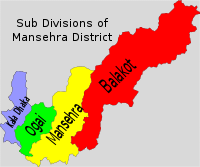Mansehra District (Hindko, Urdu: ضلع مانسہرہ) is a district in the Hazara Division, Khyber Pakhtunkhwa, northern Pakistan. Mansehra city serves as the headquarters of the district. It is home to Swati tribe of Pashtuns and formerly known as Mulk-E Pakhal, as conquered by Sultan Pakhal Gibari in late 1190s and then again by his descendents known as Swatis in 1640.
Mansehra was established as an independent district in 1976. It was previously a tehsil within the broader Hazara District.[3] In 1993, a former subdivision of Mansehra, Battagram, was separated as an independent district.[4] Similarly, in 2011, another subdivision of Mansehra, Kala Dhaka, was separated which is now known as Torghar District.
Demographics
| Year | Pop. | ±% p.a. |
|---|---|---|
| 1951 | 260,631 | — |
| 1961 | 373,975 | +3.68% |
| 1972 | 552,842 | +3.62% |
| 1981 | 686,308 | +2.43% |
| 1998 | 978,157 | +2.11% |
| 2017 | 1,555,742 | +2.47% |
| 2023 | 1,797,177 | +2.43% |
| Sources:[5] | ||
At the time of District the 2017 census, the district had 235,230 households and a population of 1,555,742. Mansehra had a sex ratio of 1015 females per 1000 males and a literacy rate of 62.56% - 75.25% for males and 50.41% for females. 144,898 (9.31%) lived in urban areas. 28.73% of the population were under 10 years of age. 427 (0.03%) people in the district were from religious minorities.[1]
Languages of Mansehra district (2017)
Similarly, 66.48% of the population spoke the Punjabi variety of Hindko and 17.02% Pashto as their first language. 14.26% of the population spoke a language recorded as 'Others' on the census, mainly Kohistani languages.
Many of these, especially in the upper Kaghan Valley, are speakers of the Kohistani dialects. There are also speakers of the widely dispersed Gujari language, particularly in the Kaghan Valley.[6] The local variety is intermediate between the eastern dialects of Gujari (spoken in Azad Kashmir) and the western group (from Chitral, Swat and Gilgit).[7] There is also a small community in the village of Dana in Oghi Tehsil who speak the endangered Mankiyali language.[8] Many people can write and speak English.[citation needed]
Constituencies
The district is represented in the Khyber Pakhtunkhwa Assembly by elected MPAs who represent the following constituencies:[9]
Constituency and current member :
- PK-36 (Mansehra-I) , Munir Lughmani Swati
- PK-37 (Manshera-II) , Babar Saleem Swati
- PK 38 (Mansehra III) , Zahid Chanzeb Swati
- PK 39 (Mansehra IV), Ikram Ghazi Tanoli
- PK 40 (Mansehra V) , Sardar Shah Jahan
The district is represented in the National Assembly of Pakistan by two elected MNAs who represent the following constituencies:
- NA-14 (Mansehra-I), Sardar Muhammad Yousaf
- NA-15 (Mansehra Torghar), Shahzada Gustasip Khan Swati
Administrative divisions

Mansehra District consists of six tehsils, with Tanawal Tehsil separated from the other five in December 2022.[10]
- Balakot (Urdu: تحصیل بالاکوٹ; Pashto: بالاکوټ تحصیل)
- Mansehra (Urdu: تحصیل مانسہرہ; Pashto: مانسهره تحصیل)
- Oghi (Urdu: تحصیل اوگی; Pashto: اوګي تحصیل)
- Baffa Pakhal (Urdu: تحصیل بفہ پکھل; Pashto: بفه پکلي تحصیل)[11]
- Darband (Urdu: تحصیل دربند; Pashto: دربند تحصیل)[12]
- Tanawal
The Kala Dhaka tehsil was separated as Torghar District in 2011.
Provincial Assembly
| Member of Provincial Assembly | Party Affiliation | Constituency | Year |
|---|---|---|---|
| Munir Lughmani Swati | Pakistan Tehreek-e-Insaf | PK-36 Mansehra-I | 2024 |
| Babar Saleem Khan Swati | Pakistan Tehreek-e-Insaf | PK-37 Mansehra-II | 2024 |
| Zahid Chanzeb Swati | Pakistan Tehreek-e-Insaf | PK-38 Mansehra-III | 2024 |
| Ikram Ghazi Khan Tanoli | Pakistan Tehreek-e-Insaf | PK-39 Mansehra-IV | 2024 |
| Sardar Shah Jahan Yousaf | Pakistan Muslim League (N) | PK-40 Mansehra-V | 2024 |
Notable people
See also
References
- ^ a b "District Wise Results / Tables (Census - 2017)". www.pbscensus.gov.pk. Pakistan Bureau of Statistics.
- ^ "Kolai-Palas made district, Baffa-Pakhal tehsil". 26 August 2017.
- ^ Census report of Mansehra 1998, p. 1.
- ^ Census report of Batagram 1998, p. 18.
- ^ "Population by administrative units 1951-1998" (PDF). Pakistan Bureau of Statistics.
- ^ Hallberg & O'Leary 1992, p. 96.
- ^ Hallberg & O'Leary 1992, pp. 112–13, 135The particular variety studied was from the village of Mittikot, six kilometres west of Balakot.
- ^ Anjum & Rehman 2015.
- ^ › reports
- ^ "Tanawal notified as sixth tehsil of Mansehra". Dawn. 26 December 2022. Retrieved 31 December 2022.
- ^ "Kolai-Palas made district, Baffa-Pakhal tehsil". 26 August 2017.
- ^ "Kolai-Palas made district, Baffa-Pakhal tehsil". 26 August 2017.
Bibliography
- 1998 District census report of Batagram. Census publication. Vol. 18. Islamabad: Population Census Organization, Statistics Division, Government of Pakistan. 1999.
- 1981 District census report of Mansehra. District Census Report. Vol. 23. Islamabad: Population Census Organization, Statistics Division, Government of Pakistan. 1983.
- 1998 District census report of Mansehra. Census publication. Vol. 62. Islamabad: Population Census Organization, Statistics Division, Government of Pakistan. 2000.
- Anjum, Uzma; Rehman, Khawaja (2015). "A First Look at Mankiyali Language: An Endangered Language". Journal of Asian Civilizations. 38 (1): 177–90. ProQuest 1816873650.
- Hallberg, Calinda E.; O'Leary, Clare F. (1992). "Dialect Variation and Multilingualism among Gujars of Pakistan". In O'Leary, Clare F.; Rensch, Calvin R.; Hallberg, Calinda E. (eds.). Hindko and Gujari. Sociolinguistic Survey of Northern Pakistan. Islamabad: National Institute of Pakistan Studies, Quaid-i-Azam University and Summer Institute of Linguistics. pp. 91–196. ISBN 969-8023-13-5.



Recent Comments